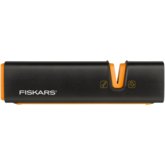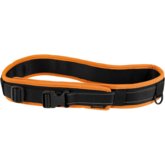
How to chop firewood safely
When used right, the axe is the fastest and most energy efficient tool for chopping your firewood. Here’s how you’ll make chopping firewood safe and enjoyable.
Remember these when chopping wood
When filling up your own firewood storage, it’s important to start well in advance. Firewood needs time to dry up before it’s ready for burning and as weather conditions affect the drying process, it’s not easy to speed it up. If the weather is dry, firewood usually takes a minimum of four months to dry from felling, but usually it’s good to be prepared to wait for a full year. Burning wet wood will give you little heat energy – it will be spent on drying up the wood, not warming up your house, stove or sauna.

Choosing the right axe
Choose the axe that is most suitable for the task and your body type. A splitting axe is best for splitting logs and making firewood, while a general-purpose axe is ideal for smaller logs and kindling. The handle of the splitting axe should be approximately the length of your arm, as indicated in the picture.

Safe working area and equipment
When you start chopping your firewood, make sure your work area is safe and cleared out of branches, stones and other objects. Remember that when splitting logs, they can shoot even meters away – take care of safe distances. Use safety glasses and gloves. You can use a sappie for holding the logs in place safely and ergonomically.

Sharpening the axe
Before chopping your firewood, make sure your axe is sharpened. The easiest way to sharpen an axe is by using a XSharp sharpener. Start by setting the sharpener to the appropriate angle for the axe. Next, place the axe blade in the sharpener and pull the axe towards yourself. Repeat this three to five times. The axe is sharp enough when it easily makes a cut in the surface of a log.

Chopping block and its distance
You need a sturdy log used as a chopping block. A hardwood log, typically 60–80 cm high (such as oak or birch), works well for this purpose. When measuring your distance to the log, hold the axe straight in front of you. You should be able to reach the log without standing too close. A log of the right height, placed at the correct distance, provides safety, as a missed swing will hit the log rather than anything else.

A good chopping position
Stand straight with your legs wide open, weight on your hips. The wide stand ensures you don’t get injured, if your blade slips past the log. The swing should feel effortless and controlled, in a steady rhythm.

A secure axe grip
Your grip on the axe should be relaxed – there's no need to squeeze it so tightly that your knuckles turn white, as long as your grip feels secure. Place your stronger hand lower down to generate more power in the swing. Wear gloves if needed. And then, off you go with the wood chopping
The best tips for chopping firewood
- Learn to read the wood and how its grain runs. Always split along the grain.
- Thick logs split more easily if you strike the edge of the log with the axe. Fresh wood splits more easily than completely dry wood.
- Your hands and back can tire quickly when chopping logs. By using a sappie to lift the logs onto the chopping block, you’ll save yourself unnecessary effort and strain.
Tip! Start with easy small logs to warm up. Tackle the difficult ones next, when you still have energy and leave the easier ones for the end.

Avoid branch spots
If you log has branch spots, turn the knot parts to the bottom and to the side. Avoid branch spots, they are hard to split.

More one-strike splits
Try to aim your axe in the middle of the log or on any visible cracks. This way, you'll increase your efficiency in chopping logs and achieve more one-strike splits.

Use a splitting wedge as a help
For very big logs, use a splitting wedge. Once you've made the first split in the wood, insert a wooden wedge into the crack and aim your final axe strike at the open split.
Tips for making kindling
Kindling runs out quickly, so it’s a good idea to make a larger batch at once. Twigs, small chips, and bark are also great for starting a fire. You can make kindling from any type of wood, but resinous woods like spruce are slightly better for igniting a fire. A smaller universal axe is the best tool for the job, as it’s lighter and easier to handle with one hand. You can use a sappie for holding and lifting the logs.

Sappie for holding and lifting the logs
Use a smaller sappie for holding the logs in place easily and safely, when making kindling. By using a sappie to lift logs and firewood, you save yourself from unnecessary bending and strain. When it's time to use the axe, you can easily hook the sappie onto the side of the chopping block.

Making kindling with a smaller axe
Making kindling requires precision, which is why a X-series™ ultra light hiking axe or a smaller universal axe, easy to handle with one hand, is the best tool for the job. It's also worth saving the small chips and bark, as they're excellent for starting a fire.

Making kindling with a Norden knife
Beautiful and functional Norden outdoor knife excels at tasks like making kindling while camping. The birch wood handle provides a good grip, even when wet.
Which wood to burn?
Hard deciduous and fruit trees, such as oak, maple, birch, and many fruit trees, are denser and therefore more heat-efficient than softer coniferous trees like pine, alder, spruce, or fir, which burn faster and produce less heat. Birch provides approximately 1.5 times more heat energy compared to a spruce tree. Spruce is also harder to chop because it has many branches; however, conifers typically dry out much faster.
If you use a fireplace more for enjoyment and atmosphere than for heating a house or sauna, any wood will suffice. However, for heating purposes, it’s best to opt for deciduous trees.

Drying firewood
Spring is ideal for chopping firewood because you can leave it to dry outside in the dry, sunny spring air. Little rain won’t hurt, because too dry air might stuck the wood’s pores and slow down the drying process.
Pile firewood off the ground – air needs to circulate freely.Cut wood dries faster and is less likely to be affected by damp or rot, than uncut wood.

Storing firewood
The storage place for firewood affects both the drying of the wood and the quality of the wood being burned. Therefore, it is not advisable to store logs on a damp surface or in a closed container, for example.
A firewood shed that can be filled from two directions and holds enough logs for two years is an excellent solution for storing firewood. This way, the logs can be loaded from one side in alternate years and unloaded from the other.
If you don't have access to a shed and will be stacking the wood outside in a log rack or next to a wall, it might be a good idea to stack the wood with the bark facing up. This will protect the wood from moisture. If you pile the wood next to the wall, make sure to leave a gap between the wood and the wall to let air circulate. Make sure the wood is off the ground, partially covered, and preferably stacked in a spot that receives sun and wind. This will help the firewood to dry out in approximately 6–12 months.
When considering the location of the firewood shed and outdoor storage, fire safety regulations must be taken into account.

The use of ash in the garden
The best ash for garden use comes from burning dry, clean hardwood from deciduous trees. Hardwood ash generally contains fewer heavy metals than conifer ash, not to mention ash from construction and demolition waste wood. Wood ash has many uses in the garden: it can be spread on the soil, sprinkled directly on plants, or mixed into compost. The recommended amount of ash to use also varies greatly depending on the soil, but a good rule of thumb is to apply a few handfuls (about 100 grams) per square metre. If you accumulate large amounts of ash regularly, it is better to dispose of it as general waste in the rubbish bin.
Clean wood ash contains calcium, phosphorus, potassium, and several trace elements that are essential for plant growth. The nutrient composition varies depending on the source of the ash, such as the type of wood and the burning temperature.
Note! Always wait until the ash is completely cool before placing it in the waste bin or spreading it in the garden or compost.












